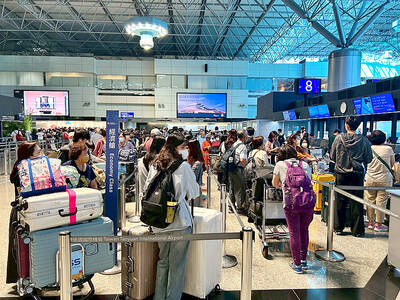The waters around Taiwan are expected to become the focus of increased military movements, a defense analyst has said.
Su Tzu-yun (蘇紫雲), a senior analyst at the government-funded Institute for National Defense and Security Research, made the remark in a paper titled US Strategic Mobility in Deployment to Ensure Regional Security.
The area covers the Miyako Strait, the Bashi Channel, the East China Sea, the South China Sea and the Philippine Sea, Su said.
The Indo-Pacific region is facing tensions caused by the COVID-19 pandemic and China’s increased military projection, especially in the South China Sea, where Beijing has built artificial islands, deployed nuclear submarines and announced administrative districts, Su said.
With the absence of US carrier strike groups in the region over the past few months due to the pandemic, Beijing’s policy of “militarizing, nuclearizing and domesticalizing” the South China Sea has affected regional security, stability and the strategic nuclear balance, he said.
However, the US Navy on May 10 announced that six of its aircraft carriers — the Harry S. Truman, Dwight D. Eisenhower, Ronald Reagan, Nimitz, Abraham Lincoln and Gerald R. Ford — returned to action, ending the military vacuum in regions around the world, Su said.
The US’ adjustments to its Indo-Pacific strategy requires close attention, Su said, pointing to the shift in rationale from “continuous bomber presence mission” to a “strategically predictable, but operationally unpredictable” approach, as indicted in the US 2018 National Defense Strategy.
One example of this is the introduction of US B-1B supersonic heavy bombers to the East China and South China seas in the past few months, including one instance on May 8, when two B-1Bs flew to the South China Sea via the Bashi Channel and the Sulu Sea in a pincer formation, Su wrote.
Regarding traditional military deployments, the US is seeking to bolster the combat capabilities of its amphibious assault ships, and has deployed anti-ship missiles with its army and marine units for waterway blockage when necessary, in support of its navy, Su said.
“The US strategic mindset in countering China’s air and sea expansions is through exterior-line operations for multidirectional suppressions,” he wrote.
“In terms of geostrategy, the US is focusing on waters such as the Miyako Strait, Bashi Channel, East China Sea, South China Sea and Philippine Sea,” he said.
Competition for land and sea power would be crucial to international politics and regional security in the post-pandemic period, he added.

Three batches of banana sauce imported from the Philippines were intercepted at the border after they were found to contain the banned industrial dye Orange G, the Food and Drug Administration (FDA) said yesterday. From today through Sept. 2 next year, all seasoning sauces from the Philippines are to be subject to the FDA’s strictest border inspection, meaning 100 percent testing for illegal dyes before entry is allowed, it said in a statement. Orange G is an industrial coloring agent that is not permitted for food use in Taiwan or internationally, said Cheng Wei-chih (鄭維智), head of the FDA’s Northern Center for

The Chinese military has built landing bridge ships designed to expand its amphibious options for a potential assault on Taiwan, but their combat effectiveness is limited due to their high vulnerability, a defense expert said in an analysis published on Monday. Shen Ming-shih (沈明室), a research fellow at the Institute for National Defense and Security Research, said that the deployment of such vessels as part of the Chinese People’s Liberation Army (PLA) Navy’s East Sea Fleet signals a strong focus on Taiwan. However, the ships are highly vulnerable to precision strikes, which means they could be destroyed before they achieve their intended

LOOKING NORTH: The base would enhance the military’s awareness of activities in the Bashi Channel, which China Coast Guard ships have been frequenting, an expert said The Philippine Navy on Thursday last week inaugurated a forward operating base in the country’s northern most province of Batanes, which at 185km from Taiwan would be strategically important in a military conflict in the Taiwan Strait. The Philippine Daily Inquirer quoted Northern Luzon Command Commander Lieutenant General Fernyl Buca as saying that the base in Mahatao would bolster the country’s northern defenses and response capabilities. The base is also a response to the “irregular presence this month of armed” of China Coast Guard vessels frequenting the Bashi Channel in the Luzon Strait just south of Taiwan, the paper reported, citing a

About 4.2 million tourist arrivals were recorded in the first half of this year, a 10 percent increase from the same period last year, the Tourism Administration said yesterday. The growth continues to be consistent, with the fourth quarter of this year expected to be the peak in Taiwan, the agency said, adding that it plans to promote Taiwan overseas via partnerships and major events. From January to June, 9.14 million international departures were recorded from Taiwan, an 11 percent increase from the same period last year, with 3.3 million headed for Japan, 1.52 million for China and 832,962 to South Korea,